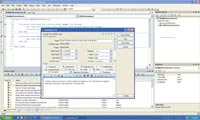Product Reviews
Managing Projects with Axosoft OnTime
OnTime is a tremendously capable project management system that's good-but not perfect-when supporting Visual Studio developers.
OnTime is a feature-rich project management system designed specifically for software projects. The product understands a world where project stakeholders are connected by the Internet rather than geography. You can install OnTime on your local area network, or you can also choose to let Axosoft host your project management solution. If you choose to install, a remote server option lets developers not on your local network link to OnTime.
Setting up a project in OnTime is quick, easy and intuitive. An OnTime project is a flexible construct that can encompass multiple Visual Studio projects and include tasks, features, defects and other projects. The reporting system provides a wide variety of ways to view a project's status, plan schedules, view workloads, and keep track of project commitments and deliverables. OnTime tasks can be associated with items in your source-management control system. The one stumbling block I ran into occurred when I tried to use VSSConnect to connect to a remote copy of Visual SourceSafe, which OnTime did not support.
Connect with Customers
OnTime Professional's default customer portal allows access to project information for up to five named customers and an unlimited number of anonymous users (you can add more users for an additional fee). This allows your customers to view and update project information without having to bother you. The configurable notification system lets you keep remote members of the team and other stakeholders integrated through e-mail or wiki page updates when information in the project changes.

[Click on image for larger view.] |
| Figure 1. The OnTime window allows you to see all tasks to which you're assigned. You can add, remove or update tasks without leaving Visual Studio. |
OnTime integrates with Visual Studio through a dockable window (Figure 1). OnTime also ties into source control so you can assign files to tasks, check items in or out from OnTime dialogs, and update items' statuses when checking them in.
From the point of view of the lone developer or manager of a small consulting firm, OnTime has a lot going for it. The pay-as-you-go monthly plan for the hosted option means that you don't have to spend capital dollars to get a sophisticated project-management tool. The installation is minimal for the hosted service, so you can be setting up projects in a few minutes.
OnTime's integration with Visual Studio is admirable: Developers can perform most OnTime-related tasks from the OnTime window without leaving Visual Studio. Full integration would provide more, however. The task list in the OnTime window should show just the tasks that I'm assigned to without having to filter the list. When I open a Visual Studio Solution or a file in a solution, I should automatically see the tasks that I'm assigned to that are related to those files. And when I select a task in the OnTime window, I should have the option to open the related files in Visual Studio. Even with these items on my wish list for Visual Studio integration, I'd consider adopting OnTime.
OnTime Professional
Axosoft LLC
Web: www.axosoft.com
Phone: 800-653-0024
Price: OnTime Professional is $795 for five users installed, $79 a month hosted
Quick Facts: Software project-management with a hosted option and Visual Studio integration
Pros: Lots of functionality, easy to use, strong support for distributed teams and other stakeholders
Cons: No support for remote Visual SourceSafe connections, integration with Visual Studio could be improved
About the Author
Peter Vogel is a system architect and principal in PH&V Information Services. PH&V provides full-stack consulting from UX design through object modeling to database design. Peter tweets about his VSM columns with the hashtag #vogelarticles. His blog posts on user experience design can be found at http://blog.learningtree.com/tag/ui/.